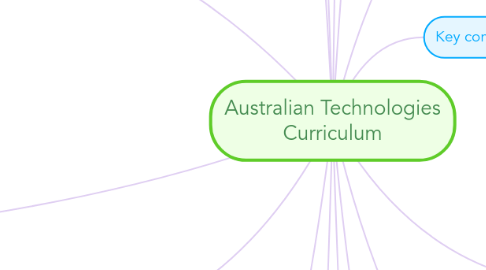
1. Content structure
1.1. Design and Technologies
1.1.1. Knowledge, understanding and skills in each subject are presented through two related strands:
1.1.1.1. Knowledge and understanding
1.1.1.1.1. Technologies and society
1.1.1.1.2. Technologies contexts
1.1.1.2. Processes and production skills.
1.1.1.2.1. Creating designed solutions by: investigating generating producing evaluating collaborating managing
1.2. Digital Technologies
1.2.1. Knowledge, understanding and skills in each subject are presented through two related strands:
1.2.1.1. Knowledge and understanding
1.2.1.1.1. Representation of data
1.2.1.1.2. Digital systems
1.2.1.2. Processes and production skills.
1.2.1.2.1. Collecting, managing and analysing data Creating digital solutions by: defining designing implementing evaluating collaborating and managing
2. General Capabilities
2.1. Literacy
2.2. Numeracy
2.3. Information and communication technology (ICT) capability
2.4. Critical and creative thinking
2.5. Personal and social capability
2.6. Ethical understanding
2.7. Intercultural understanding.
3. Band Levels
3.1. Foundation –Year 2
3.2. Years 3 and 4
3.3. Years 5 and 6
3.4. Years 7 and 8
3.5. Years 9 and 10.
4. Key ideas in the Technologies Curriculum
4.1. Overarching idea: Creating preferred futures
4.1.1. Computational thinking
4.1.2. Design Thinking
4.1.3. Systems thinking
4.1.4. Project management
5. Band descriptions
5.1. Band descriptions provide information about the learning contexts that apply to the content descriptions and achievement standards in each Technologies subject in each band.
6. Content descriptions
6.1. Content descriptions at each band describe the knowledge, understanding and skills that teachers are expected to teach and students are expected to learn.
7. Resources
7.1. URL
7.2. URL
8. Curriculum Aims
8.1. Investigate, plan, create and evaluate solutions.
8.2. Use innovation and enterprise when working with traditional, contemporary and emerging technologies.
8.3. Engage confidently and select responsibly a range of technologies.
8.4. Make informed and ethical decisions.
9. Key concepts
9.1. Technologies enrich and impact individuals and societies.
9.2. The role of technologies are always changing and advancing.
9.3. In an increasingly technological and complex world, it is important to develop knowledge and skills to analyse and creatively respond to design and/or digital challenges.
10. Reference List
11. Student Diversity
11.1. Students with disability
11.1.1. curriculum adjustments are necessary to provide equitable opportunities for students to access age-equivalent content in the Australian Curriculum: Technologies.
11.2. English as an additional language or dialect
11.2.1. While the aims of the Australian Curriculum: Technologies are the same for all students, EAL/D students must achieve these aims while learning a new language and content skills through that new language. These students may require additional time and support, along with teaching that explicitly addresses their language needs.
11.3. Gifted and talented students
11.3.1. Teachers can use the Australian Curriculum: Technologies flexibly to meet the individual learning needs of gifted and talented students.
